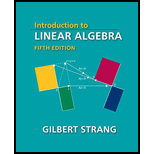
(a)
The eigenvalues of given matrices and the answer of given question.
Answer to Problem 1PS
Explanation of Solution
Given:
Matrices are
Concept Used:
If T is a linear transformation such that
i.e., mapping from a
Where λis a scalar in the field F, known as the eigenvalue or characteristic value, or characteristic root or proper values, or latent roots associated with the eigenvector v.
If
We can also say that any number such that a given matrix minus that number times the identity matrix has zero determinant, the equation formed from this operation termed as characteristic equation which have a roots thereby termed as characteristic root.
The given matrix
Has atmost n eigenvalues and thereby n eigenvector.
- Two matrices can be added or subtracted if they are of the same order.
- Two matrices can be multiplied if the number of columns of first matrix is equal to the number of rows of second matrix.
Calculation:
Given matrices are
Since, above matrices are of order two hence it have at most two eigenvalues say
Since, we know that for any given matrix minus that number times the identity matrix has zero determinant. Thus, using the given matrix A we get
and the associated characteristic equation and thereby the characteristic root of the given matrix will be obtained as
Now, using the given matrix
and the associated characteristic equation and thereby the characteristic root of the given matrix will be obtained as
Let
Now, using the given matrix C we get
and the associated characteristic equation and thereby the characteristic root of the given matrix will be obtained as
As we have
Let us reduce the matrix A in its echelon form.
Operate
Operate
Operate
Conclusion:
As can be seen that eigenvalues of increasing power of A is equal to the power of eigenvalues of A. Different powers of A have different eigenvalues. Eigenvalues of reduced form of matrix is different from its original form.
(b)
Why the matrix having eigenvalues zero, does not changed by the steps of elimination?
Explanation of Solution
Concept Used:
If T is a linear transformation such that
i.e., mapping from a vector space V over a field F into itself and
Where λis a scalar in the field F, known as the eigenvalue or characteristic value, or characteristic root or proper values, or latent roots associated with the eigenvector v.
If
We can also say that any number such that a given matrix minus that number times the identity matrix has zero determinant, the equation formed from this operation termed as characteristic equation which have a roots thereby termed as characteristic root.
The given matrix
Consider a matrix
Since, above matrices are of order two hence it have at most two eigenvalues say
Since, we know that for any given matrix minus that number times the identity matrix has zero determinant. Thus, using the given matrix A we get
and the associated characteristic equation and thereby the characteristic root of the given matrix will be obtained as
The given matrix
Hence, the given matrix always have zero eigenvalues and which cannot be avoided even after elimination process on the matrix.
Want to see more full solutions like this?
Chapter 6 Solutions
Introduction to Linear Algebra, Fifth Edition
 Algebra and Trigonometry (6th Edition)AlgebraISBN:9780134463216Author:Robert F. BlitzerPublisher:PEARSON
Algebra and Trigonometry (6th Edition)AlgebraISBN:9780134463216Author:Robert F. BlitzerPublisher:PEARSON Contemporary Abstract AlgebraAlgebraISBN:9781305657960Author:Joseph GallianPublisher:Cengage Learning
Contemporary Abstract AlgebraAlgebraISBN:9781305657960Author:Joseph GallianPublisher:Cengage Learning Linear Algebra: A Modern IntroductionAlgebraISBN:9781285463247Author:David PoolePublisher:Cengage Learning
Linear Algebra: A Modern IntroductionAlgebraISBN:9781285463247Author:David PoolePublisher:Cengage Learning Algebra And Trigonometry (11th Edition)AlgebraISBN:9780135163078Author:Michael SullivanPublisher:PEARSON
Algebra And Trigonometry (11th Edition)AlgebraISBN:9780135163078Author:Michael SullivanPublisher:PEARSON Introduction to Linear Algebra, Fifth EditionAlgebraISBN:9780980232776Author:Gilbert StrangPublisher:Wellesley-Cambridge Press
Introduction to Linear Algebra, Fifth EditionAlgebraISBN:9780980232776Author:Gilbert StrangPublisher:Wellesley-Cambridge Press College Algebra (Collegiate Math)AlgebraISBN:9780077836344Author:Julie Miller, Donna GerkenPublisher:McGraw-Hill Education
College Algebra (Collegiate Math)AlgebraISBN:9780077836344Author:Julie Miller, Donna GerkenPublisher:McGraw-Hill Education





